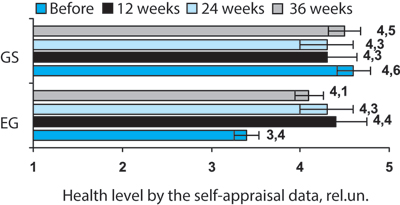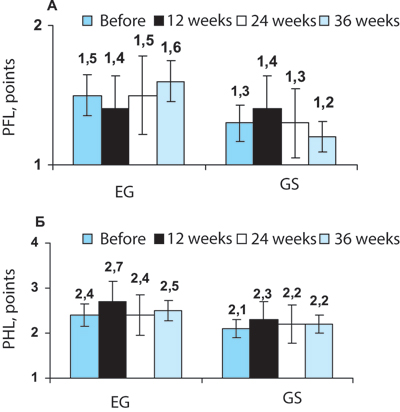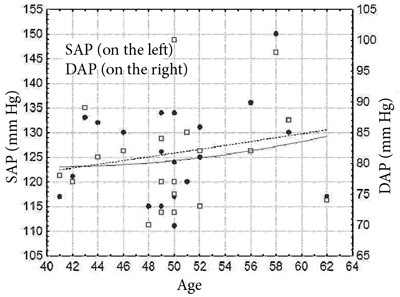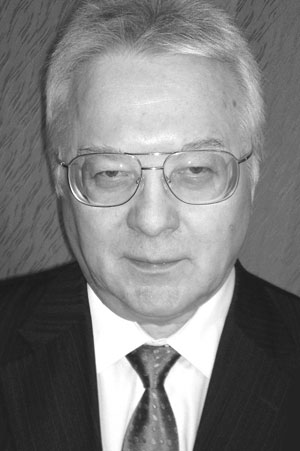The influence of physical exercises on physical fitness and health characteristics of fifty-year-old women within KhMAR-Ugra
Фотографии:
ˑ:
S.I. Loginov, professor, Dr.Biol.
M.N. Mal'kov, associate professor, Ph.D.
A.S. Kintyukhin, postgraduate
M.V. Batraeva, postgraduate
R.O. Solodilov, postgraduate
Laboratory of biomechanics and kinesiology, Surgut state university of KhMAR-Ugra, Surgut
Key words: cardiorespiratory system, physical exercises, regular physical loading, physical health, 50-year-old women, physical fitness.
Introduction. It is common knowledge that the process of ageing is diverse [1]. Bone tissue mineralization decreases with age with frequently developing osteoporosis and high risk of spontaneous fractures [5, 9, 11]. The cartilaginous tissue is subject to changes, provoking spinal curvatures and decrease of human height. Herewith, ageing provokes fault in posture and gait disorder, resulting in even more unstable balance. Moreover, thrombus can be formed in the vessels of an elderly person, resulting in potential ischemic strokes [2]. Ageing stipulates for the vital capacity decrease, reduction of pulmonary capillaries and finally lower functional abilities of the external respiration apparatus, especially at various physical loadings. In respect to digestive organs, changes happen in cholestasia in gallbladder, atrophy of stomach and intestinal motor and secretory functions, causing constipations [7]. Seniors have high blood cholesterol and more probability of forming atheromas [8]. The observed physiological and morphological changes in senior people of the Khanty-Mansiisk autonomous region - Ugra are aggravated by specific climate and environmental conditions and unfavorable ecology [6]. So health indicators need to be maintained and corrected by means of regular physical exercises. Meanwhile, there is not enough systematic information on the subject.
The purpose of the study was to examine the specifics of the influence of regular classes of recreational physical culture on the characteristics of physical fitness and health of 50-year-old females, permanent residents of the KhMAR-Ugra.
Materials and methods. The study involved 20 women, randomly selected from the staff of Surgut state university. All the subjects were divided into the experimental group (n = 10, age 49,4 ± 4,35 years) with a control exposure, presented in the form of 36 week long specialized fitness trainings and the comparison group (n = 10, age 50.7 ± 6,73 years) working independently on occasion. Prior to the study women had their body length (BL) measured barefoot using a standard auxameter accurate within 0.5 cm, body weight (BW) determined using medical scales accurate within 100g, expiratory (expiratory CC, cm) and inspiratory (inspiratory CC, cm) and pause chest circumference (pause CC, cm), waist (WC, cm) and hip circumference (HC, cm) measured with a measure tape accurate within 0.5 cm. In addition, the input diagnostics of indicators of cardiorespiratory system was held in the relative rest position and after a standardized 3 minute exercise test "sit - stand". The indices registered included heart rate (HR, bpm) at rest, after exercise and during recovery, systolic (SAP, mm Hg) and diastolic (DAP, mm Hg) arterial pressure in the relative rest position, vital capacity (VC, ml) and timed inspiratory capacity (Stange’s test, sec). Physical fitness level, physical health, personal, situational anxiety and self-appraisal of health status were determined using an array of tests of the expert system “CosMos” [3, 4]. The control action (independent variable) represented a combination of recreational training classes using aerobic (walking and running on a treadmill by Bremshey), power (dead load exercises and using specialized weight machines) physical exercises. The indicated exercises were combined with breathing exercises and stretching. The classes were held 3 times a week and lasted 40-50 minutes. The repeated diagnostics was made after 12, 24 and 36 weeks. The descriptive statistics and regression analysis were made using the software Statistica_6 with allocation of reliability of differences by the Student and Wilcoxon criteria at the significance level p≤0,05.
Results and discussion. The comparison of anthropometric and functional parameters in the experimental group of women and the comparison group before the study has not revealed any statistically significant differences (Table 1).
It has been shown that women regularly engaged in fitness trainings using aerobic physical exercises (walking and running on a treadmill), power exercises (dead load exercises and using specialized weight machines) significantly decreased their body weight and body mass index during 36 weeks of classes. At the same time body weight and body mass index of women engaged on occasion (comparison group), on the contrary, increased significantly already after 12 weeks and remained in this form within the next 24 weeks of observation.
Characteristically, a decrease in expiratory waist and chest circumference was marked to decrease in the experimental group after 36 weeks of regular trainings. The hip size reduction occurred after 24 weeks of fitness trainings. In the comparison group no similar changes were found (Table 1).
Table 1. The dynamics of anthropometric indices of women aged 50 years during 36 week trainings, Ме (±95% CI)
|
Indices |
Experimental group (n=10) |
Comparison group (n=10) |
||||||
|
Before |
After 12 weeks |
After 24 weeks |
After 36 weeks |
Before |
After 12 weeks |
After 24 weeks |
After 36 weeks |
|
|
1 |
2 |
3 |
4 |
5 |
6 |
7 |
8 |
|
|
Age, years |
50,0 (46,3; 52,5) |
50,0 (46,4; 52,6) |
50,5 (47,1; 53,3) |
51,0 (47,2; 53,8) |
49,5 (45,9; 55,5) |
50,0 (46,1; 55,7) |
50,5 (46,5; 56,3) |
50,5 (46,9; 56,5) |
|
Body length, cm |
161,0 (155,2; 166,8) |
161,0 (155,1; 166,6) |
161,0 (155,1; 166,6) |
161,5 (155,2; 166,7) |
163,0 (159,3; 168,3) |
163,0 (159,5; 168,3) |
163,5 (159,4; 168,4) |
163,0 (159,3; 168,3) |
|
Body weight, kg |
73,0 (62,4; 87,8) |
71,5 (61,1; 86,1) * 2,1 |
70,5 (60,5; 84,9) * 3,1; 3,2 |
71,0 (60,1; 84,3) * 4,1 |
76,5 (66,8; 86,1) |
83,0 (68,7; 87,7) * 6,5 |
83,0 (68,5; 88,3) * 7,5 |
82,5 (68,2; 87,6) |
|
BMI, kg/m2 |
27,6 (25,4; 31,9) |
27,6 (25,1; 31,2) * 2,1 |
27,2 (24,9; 30,7) * 3,1; 3,2 |
26,9 (24,7; 30,4) * 4,1 |
26,9 (24,2; 33,3) |
28,2 (24,9; 33,7) * 6,5 |
28,1 (24,9; 33,9) * 7,5 |
28,2 (24,8; 33,7) |
|
Expiratory CC, cm |
94,0 (87,9; 106,2) |
93,0 (86,3; 103,7) * 2,1 |
93,5 (86,6; 103,3) * 3,1 |
92,0 (86,2; 103,0) * 4,1 |
98,5 (93,0; 103,6) |
96,5 (92,7; 101,7) |
96,5 (92,8; 102,6) |
96,0 (92,4; 102,1) |
|
Inspiratory CC, cm |
99,0 (92,8; 109,8) |
100,0 (92,3; 107,9) |
99,5 (92,6; 107,6) |
100,0 (92,8; 108,4) |
101,5 (97,4; 107,2) |
101,5 (97,4; 106,8) |
101,5 (97,0; 106,4) |
99,5 (96,8; 106,2) |
|
Pause CC, cm |
96,0 (90,0; 107,2) |
95,5 (88,6; 105,1) |
95,5 (89,0; 105,2) |
95,5 (89,0; 105,2) |
100,0 (94,6; 105,2) |
99,0 (94,4; 104,4) |
100,5 (95,0; 104,6) |
97,5 (93,9; 103,6) |
|
Waist circumference, cm |
86,5 (79,9; 99,3) |
85,5 (78,7; 97,9) |
84,5 (78,2; 97,0) * 3,1 |
85,4 (78,2; 97,0) * 4,1 |
88,5 (81,8; 98,8) |
87,5 (81,3; 99,3) |
87,5 (81,7; 99,9) |
89,5 (81,4; 101,2) |
|
Hip circumference, cm |
106,0 (98,1; 112,3) |
105,0 (98,9; 111,9) |
103,5 (98,8; 111,6) * 3,1 |
102,5 (98,6; 111,2) |
110,0 (102,3; 117,7) |
110,0 (102,4; 117,8) |
109,5 (102,9; 117,9) |
110,0 (102,3; 117,5) |
|
Wrist circumference, cm |
17,0 (16,6; 18,2) |
17,0 (16,6; 18,2) |
17,0 (16,5; 18,1) |
17,0 (16,3; 18,1) |
18,0 (16,7; 19,3) |
18,0 (16,7; 19,3) |
18,0 (16,7; 19,3) |
18,0 (16,7; 19,3) |
Legend: Ме – median, CI – confidence interval, BMI – body mass index (kg/m2). p (*) – differences are significant (p<0,05) between indices in the corresponding columns.
Based on the analysis of physiological characteristics it was found that vital capacity of women of EG had significantly increased after 36 weeks of regular physical exercises (Table 2). The heart rate of women of EG was insignificantly lower than the input testing (Table 2) after a standardized 3 minute loading test "sit - stand" after 36 weeks of trainings. The comparison of EG and CG by the "sit - stand" test results has revealed that women of the experimental group had significantly lower indices of heart rate after 36 weeks of exposure, i.e. sustained loading easier and had higher physical working capacity.
Table 2. The dynamics of physiological characteristics of women aged 50 years during 36 week training, Ме (±95% CI)
|
Indices |
Experimental group (n=10) |
Comparison group (n=10) |
|||||||
|
Before |
After 12 weeks |
After 24 weeks |
After 36 weeks |
Before |
After 12 weeks |
After 24 weeks |
After 36 weeks |
||
|
1 |
2 |
3 |
4 |
5 |
6 |
7 |
8 |
||
|
VC, ml |
2850 (2459; 3305) |
2870 (2634; 3346) |
2960 (2742; 3422) * 3, 2 |
3010 (2815; 3463) * 4, 1 |
3000 (2711; 3384) |
3205 (2767; 3493) |
3150 (2796; 3445) |
3170 (2805; 3599) |
|
|
HR, bpm |
Rest |
69,0 (63,2; 77,6) |
74,5 (66,8; 81,2) |
70,0 (66,1; 76,9) |
69,0 (64,0; 73,2) |
74,0 (69,8; 83,2) |
75,0 (65,7; 82,3) |
75,5 (69,0; 83,4) |
75,5 (68,0; 82,2) |
|
Loading |
133,5 (122,0; 143,6) |
131,0 (119,0; 143,6) |
134,0 (120,1; 141,2) |
129,0 (117,3; 137,3) * 4, 8 |
142,0 (129,6; 151,2) |
138,0 (122,4; 152,8) |
149,5 (132,4; 153,2) |
145,5 (129,3; 152,3) |
|
|
Recovery |
85,5 (80,1; 100,3) |
93,0 (80,9; 105,5) |
91,0 (76,9; 102,1) |
87,0 (76,9; 97,7) |
99,5 (94,2; 109,2) |
103,0 (84,6; 111,2) |
100,0 (87,9; 108,5) |
103,5 (90,4; 108,2) |
|
|
AP, mm Hg |
Systolic |
130,5 (122,0; 136,2) |
121,5 (114,4; 132,0) |
120,5 (115,2; 134,4) |
119,0 (114,9; 130,3) |
120,5 (116,7; 128,7) |
119,5 (113,2; 126,6) |
121,5 (117,4; 125,6) |
121,0 (117,4; 127,0) |
|
Diastolic |
81,5 (75,8; 90,0) |
73,0 (70,5; 81,7) * 2, 1 |
77,5 (72,8; 87,8) * 3, 2 |
78,5 (72,4; 85,4) |
77,5 (74,5; 82,7) |
79,0 (71,2; 81,7) |
80,5 (77,1; 83,0) |
79,5 (77,0; 83,8) |
|
|
Stange’s test, sec |
40,0 (31,6; 46,4) |
41,0 (33,7; 54,1) |
55,5 (45,2; 64,0) * 3,1;3,2 |
62,5 (52,0; 71,8) * 4,1;4,3; 4,8 |
44,5 (29,2; 54,8) |
47,5 (35,1; 59,7) * 6, 5 |
50,0 (37,9; 59,7) * 7, 5 |
44,0 (34,9; 59,3) |
|
Legend: Ме – median, CI – confidence interval. p (*) – differences are significant (p<0,05) between indices in the corresponding columns.
Diastolic arterial pressure of women of EG has decreased compared to the data of the input diagnostics. Statistically significant differences were traced already after 12 weeks of exposure. Hereafter diastolic arterial pressure tended to decrease. In the comparison group there have not been detected any significant differences in this parameter (Tab. 2).
According to the results of the Stange’s test, women of the experimental group had significantly longer timed inspiratory capacity than women of the comparison group after 36 weeks of directed exposure, which testifies to higher efficiency of their respiratory system.
Moreover, women of the experimental and comparison groups had characteristic changes in the indices of situational and personal anxiety (Tab. 3).
Table 2. The dynamics of situational and personal anxiety of women aged 50 years, Ме (±95% CI)
|
Indices |
Experimental group (n=10) |
Comparison group (n=10) |
||||||
|
Before |
After 12 weeks |
After 24 weeks |
After 36 weeks |
Before |
After 12 weeks |
After 24 weeks |
After 36 weeks |
|
|
1 |
2 |
3 |
4 |
5 |
6 |
7 |
8 |
|
|
Situational anxiety, rel.un.
|
42,0 (36,2; 44,6) |
38,5 (31,1; 42,7) |
47,5 (38,3; 51,9) |
49,0 (44,6; 52,8) * 4,1 |
38,0 (33,3; 41,7) |
42,0 (32,3; 46,3) |
48,0 (45,2; 52,0) * 7,5; 7,6 |
49,5 (45,3; 52,6) * 8,5 |
|
Personal anxiety, rel.un. |
50,0 (44,1; 53,1) |
47,5 (42,8; 52,2) |
48,5 (42,6; 52,4) * 3,7 |
53,0 (45,8; 54,8) |
45,5 (40,4; 51,4) |
46,5 (41,5; 56,1) |
54,5 (50,5; 57,9) * 7,5 |
50,0 (46,8; 52,4) * 8,7 |
Legend: Ме – median, CI – confidence interval. p (*) – differences are significant (p<0,05) between indices in the corresponding columns.

Fig. 1. Changes in self-appraisal of health status of women aged 50 years in dynamics of the 36 week training process. Self-appraisal of health status is presented in relative units, where 1- low, 2 – below the average, 3 –average, 4 – above the average and 5 – high level. Vertical lines conform to 0,95 confidence interval.
Proceeding from the data adduced in Fig. 3, women of EG and comparison group assessed their health (survey “self-appraisal of health status”) as above the average. But such a dynamics has been observed for 36 weeks. On the one hand, situational and personal anxiety for the period of finishing the biomedical support (after 36 weeks) corresponded to the high level of anxiety (46 and more points). But, when considering these indices in dynamics, one can see that situational anxiety was moderate (31-45 relative units) after 12 weeks in the experimental and comparison groups of women, indicating the stable psychoemotional status of participants engaged in regular trainings.
Proceeding from the conducted studies, according to the data of the expert system we used physical fitness level of women of the experimental group varied from low to average during 36 weeks of trainings, while in the comparison group it changed from low to below the average (Fig. 2, A).

Fig. 2. Changes in physical fitness level (PFL) (А) and physical health level (PHL) (B) of women aged 50 in dynamics of the 36 week training process in the experimental and comparison groups. Physical health and physical fitness levels are shown in points, where 1 – low, 2 – below the average, 3 –average, 4 – above the average and 5 – high level.
In addition, women of the comparison group have been proved to have low health level by the end of the 36 week sports and fitness exposure, while women of the experimental group had physical health level closer to the average after 12 weeks of trainings (Fig. 2, B).
By the results of the regression analysis, the dependence of the value of arterial pressure of women at rest and their age (n=20) was clarified (n=20). Systolic (SAP) and diastolic arterial pressure (DAP) (Fig. 3) increase with age, which matches the literature data we have obtained before [14]. The dependence is described by the following regression equations: SAP = 108,2 + 032х + 0,0006х2 and DAP = 96,4 + 0,84х + 0,0105х2. The value of DAP decreased in women of EG influenced by regular trainings (Tab. 2).

Fig. 3. Dependence of the value of women’s arterial pressure and age.
Discussion. The decrease of body mass, body mass index, waist circumference and standardization of the value of arterial pressure influenced by regular fitness trainings in women was stated [13, 14, 15] by many other researchers. Physical loading (eg., number of daily steps, characterizing the level of physical activity) was proved to significantly correlate with changes of waist circumference sizes, body mass index and amount of fat mass (-0,28 ≤ R ≤ -0,20). In our observations body mass index in the sampling of Surgut women was initially lower (28,1 versus 34,2 kg/m2), than in American women of the same age [15]. BMI decreased from 27,6 (25,4; 31,9) kg/m2 (beginning of the study) to 26,9 (24,7; 30,4) kg/m2 (36 weeks of the study) (p=0,042) in the group of Surgut women engaged in regular trainings. In the group BMI, on the contrary, rose up to 28,1 (24,9; 33,9) kg/m2 (p<0,048). Since BMI characterized the degree of risk of formation of cardiovascular diseases, its increase in women of the comparison group is to be considered as a negative phenomenon.
The decrease of waist and hip circumference sizes is also seen as a favorable prognostic sign. Standards of the World Health Organization are used to estimate the increase of the risk for health, associated with waist circumference. At waist circumference < 80 cm, the usual risk is possible, at 80-88 cm - increased risk, at > 88cm - substantially increased risk. The waist circumference was 86.5 (79.9, 99.3) cm in our sample of Surgut women under study, which corresponds to the high-risk group. Under the influence of regular physical loading the value of WC decreased in the experimental group of women by more than 1 cm, while in the comparison group the value of WC increased up to 89.5 (81.4, 101.2) cm, indicating the transition to the group of significantly high risk. Changes in other indices of physical development of senior women of the set sample under study generally corresponded to the data of other authors.
We assume that during further researches one is to intensify the work on formation of commitment to regular trainings in women by using directly cognitive and behavioral strategies and consolidating the positive motor experience.
Conclusion. Regular physical exercises executed within the controlled classes stipulate for decrease of the body mass index, decrease of the waist and hip circumference, enhancement of the external respiratory function, reduction of the diastolic arterial pressure and heart rate after loading in women aged 50 years, permanent residents of the KhMAR-Ugra (Surgut).
References
- Balsevich, V.K. Human ontokinesiology / V.K. Balsevich. – Moscow: Teoriya i praktika fizicheskoy kultury, 2000. – 275 P. (In Russian)
- Butikov, V.N. Ischemic stroke in residents of the European North: analysis of risk factors / .N. Butikov et al // Arterial’naya gipertenziya – 2010. – V. 16. – № 4. – P. 373–377. (In Russian)
- Gavrilov, D.N. Innovative technologies of diagnostics of psychophysical status / D.N. Gavrilov, A.G. Komkov, A.V. Malinin. – St.Petersburg SRSIPC, 2005. – 43 P. (In Russian)
- Gavrilov, D.N. Monitoring of physical status of veterans of sport / D.N. Gavrilov, A.V. Malinin // Proceedings of the V Internat. congress “Man, Sport, Health”, April, 21-23 2011. – St.Petersburg, 2011. – P. 263–264. (In Russian)
- Dydykina, I.S. Osteoporosis: risk factors, diagnostics and pharmacotherapy. The multicentric interregional study within the “Northern star” program / I.S. Dydykina et al. // Klinicheskaya farmakologiya i terapiya. – 2007. – V. 16. – № 2. – P. 84–89. (In Russian)
- Es’kov, V.M. Ecological factors of Khanty-Mansiisk autonomous region. P. II. Human life safety in the North of the RF / V.M. Es’kov, O.E. Filatova, V.A. Karpin et al. – Samara: Ofort, 2004. – 172 P. (In Russian)
- Zhuklina, V.V. Anatomic anteroventral characteristics in elderly people (literature survey) / V.V. Zhuklina et al. // Sibirskoe meditsinskoe obozrenie. – 2012. – V. 78. – № 6. – P. 39–43. (In Russian)
- Maychuk, E.Yu. The genesis of atherosclerosis and osteoporosis among women / E.Yu. Maychuk et al. // Problemy zhenskogo zdorov’ya. – 2010. – V. 5. – № 5. – P. 51–55. (In Russian)
- Sveshnikov, A.A. Threshold values of the mineral density of skeletal bones and fracture rate / A.A. Sveshnikov et al. // Geniy ortopedii. – 2010. – № 2. – P. 85–90. (In Russian)
- Health and fitness work with elderly people: guidelines of ARRIPC / ed. by V.A. Mamaeva. – Moscow: Sovetsky sport, 2003 – 208 P. (In Russian)
- Shmeleva, S.V. The features of osteoporosis prevention among women in the critical age / S.V. Shmeleva, V.G. Taktarov // Palliativnaya meditsina i reabilitatsiya. – 2008. – № 1. – P. 33–35. (In Russian)
- Ecological factors of KhMAR. P. II. Human life safety in the North of the RF / V.M. Es’kov, O.E. Filatova, V.A. Karpin et al. – Samara: Ofort. – 2004. – 172 P.v520(In Russian)
- Kelley, G.A., 645\7Kelley, K.S., Tran, Z.V. Walking and resting blood pressure in adults: a meta-analysis. Prev Med. – 2001. – V. 33, N 2. – P. 1. – P. 120–127.
- Murphy MH, Nevill AM, Murtagh EM, Holder RL. The effect of walking on fitness, fatness and resting blood pressure: a meta-analysis of randomised, controlled trials. Prev Med. – 2007. – V. 44, N 5. – P. 377–385.
- Thomson, J.L., Landry, A.S., Zoellner, J.M., Tudor-Locke, C. et al. Several steps/day indicators predict changes in anthropometric outcomes: HUB City Steps / J.L. Thomson // BMC Public Health.– 2012.– V. 15, N 12.– P. 983–994.
Author's contacts: apokin_vv@mail.ru



 Журнал "THEORY AND PRACTICE
Журнал "THEORY AND PRACTICE